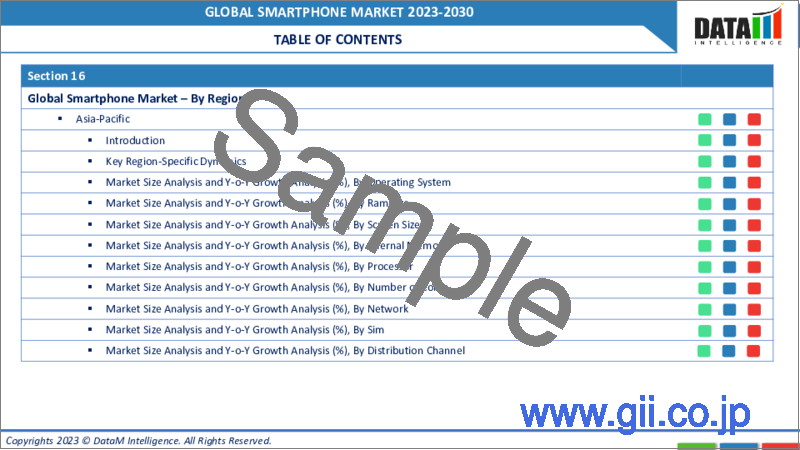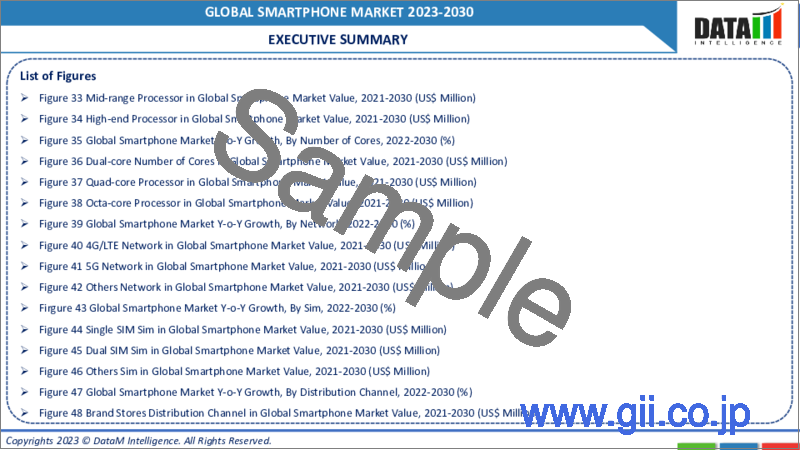|
|
市場調査レポート
商品コード
1285072
スマートフォンの世界市場- 2023-2030年Global Smartphone Market - 2023-2030 |
||||||
カスタマイズ可能
適宜更新あり
|
|||||||
| スマートフォンの世界市場- 2023-2030年 |
|
出版日: 2023年06月05日
発行: DataM Intelligence
ページ情報: 英文 152 Pages
納期: 即日から翌営業日
|
- 全表示
- 概要
- 目次
市場概要
スマートフォンの世界市場規模は2022年に5,146億米ドルに達し、2030年には7,800億1,000万米ドルに達することで有利な成長が予測されます。予測期間2023-2030年のCAGRは7.2%で成長しています。
政府のデータによると、世界のスマートフォン市場は過去10年間に大きな成長を遂げ、有利な市場機会を得てきたと予想されます。現在、世界のスマートフォンユーザーは55億人を超え、その普及率は70%を超えています。スマートフォンの普及が著しく、市場規模が拡大している背景には、価格の低下、ネットワークインフラの強化、デジタルサービスへのアクセス向上など、さまざまな要因が考えられます。
スマートフォンのユーザー数が世界的に多いことから、この業界は継続的に拡大・発展していくと考えられます。特に、Android OSは、約53%の圧倒的な市場シェアを占めています。また、地域別ではアジア太平洋地域が25%以上のシェアを獲得し、トップランナーとなっています。
市場力学
テクノロジーの進化とeコマース、デジタル決済の台頭
スマートフォン技術の急速な進歩が、市場成長の原動力となっています。高速プロセッサ、拡張カメラ、拡張現実(AR)、人工知能(AI)機能などの特徴は、消費者を惹きつけてデバイスのアップグレードを促しています。例えば、5G技術と高度なカメラシステムを搭載したアップルのiPhone 14シリーズが2022年に発売されたことは、消費者の需要と市場全体の成長を刺激しました。
さらに、eコマースプラットフォームとデジタル決済システムの台頭が、世界のスマートフォン市場の成長を促進しました。オンラインショッピングやモバイルバンキングが便利になったことで、スマートフォンは消費者にとって不可欠なツールとなりました。特に、アリペイやウィーチャットペイなどのプラットフォームに代表される中国のデジタル決済エコシステムは、同国のスマートフォン市場の拡大に寄与しています。
規制のハードル、貿易障壁、高まる環境への懸念
政府の政策と政策は、スマートフォン市場に大きな影響を与える可能性があります。貿易障壁、関税、輸入規制は、さまざまな市場におけるスマートフォンのコストと入手性に影響を与えます。政府筋からのデータでは、輸入関税の賦課、ローカライゼーション要件、厳しい認証プロセスなどが明らかにされています。
さらに、スマートフォン業界は、環境への影響や電子廃棄物管理に関する監視の目を強めています。政府筋は、電子廃棄物に対する懸念の高まりを指摘し、スマートフォンのライフサイクルを通じて持続可能な実践の必要性を強調しています。上記の事実は、世界のスマートフォン市場の市場機会を阻害する可能性があります。
COVID-19の影響分析
COVID-19の分析では、COVID以前のシナリオ、COVIDシナリオ、COVID後のシナリオに加え、価格力学(COVID以前のシナリオと比較したパンデミック時およびパンデミック後の価格変動を含む)、需給スペクトラム(取引制限、封鎖およびその後の問題による需要と供給のシフト)、政府の取り組み(政府組織による市場、セクター、産業の活性化に関する取り組み)、メーカーの戦略的取り組み(COVID問題を軽減するためにメーカーは何を行ったか)についても解説します。
目次
第1章 調査手法と範囲
- 調査手法
- 調査目的および調査範囲
第2章 定義と概要
第3章 エグゼクティブサマリー
- オペレーティングシステム別スニペット
- スニペット:ラムサイズ別
- スニペット:販売チャネル別
- 地域別スニペット
第4章 市場力学
- 影響要因
- 促進要因
- 抑制要因
- 機会
- 影響分析
第5章 産業分析
- ポーターのファイブフォース分析
- サプライチェーン分析
- 価格分析
- 法規制の分析
第6章 COVID-19の分析
- COVID-19の分析
- COVID-19の前のシナリオ
- COVID-19期間中のシナリオ
- COVID-19後のシナリオ、または将来のシナリオ
- COVID-19の中での価格・ダイナミクス
- 需給スペクトル
- パンデミック時の市場に関連する政府の取り組み
- メーカー各社の戦略的取り組み
- サマリー
第7章 オペレーティングシステム別
- アンドロイド
- Windows
- iOS
- その他
第8章 ラムサイズ別
- 2GB
- 3GB~4GB
- 6GB
- 8GB
第9章 販売チャネル別
- オンラインチャネル
- オフラインチャネル
第10章 地域別
- 北米
- 米国
- カナダ
- メキシコ
- 欧州
- ドイツ
- 英国
- フランス
- イタリア
- ロシア
- その他欧州
- 南米
- ブラジル
- アルゼンチン
- その他南米地域
- アジア太平洋地域
- 中国
- インド
- 日本
- オーストラリア
- その他アジア太平洋地域
- 中東・アフリカ地域
第11章 競合情勢
- 競合シナリオ
- 市況ポジショニング/シェア分析
- M&A(合併・買収)分析
第12章 企業プロファイル
- Samsung
- 会社概要
- 製品ポートフォリオと説明
- 財務概要
- 主な発展状況
- Apple
- Huawei
- Xiaomi
- OPPO
- Nokia
- Sony
- LG
- VIVO
第13章 付録
Market Overview
The Global Smartphone Market size reached US$ 514.6 billion in 2022 and is projected to witness lucrative growth by reaching up to US$ 780.01 billion by 2030. The market is growing at a CAGR of 7.2% during the forecast period 2023-2030.
Government data indicates that the global smartphone market has experienced significant growth and lucrative market opportunities in the past decade. Currently, the total global smartphone user base surpasses 5.5 billion, showcasing an impressive penetration rate exceeding 70%. The respective remarkable surge in smartphone adoption and the upward market trend can be attributed to various factors, such as decreasing prices, enhanced network infrastructure and greater accessibility to digital services.
Given the vast number of smartphone users worldwide, the industry is positioned for continuous expansion and advancement. Notably, the Android operating system commands a dominant market share of approximately 53%. Similarly, the Asia-Pacific region emerges as the frontrunner in the regional segment, capturing over 25% of the market share.
Market Dynamics
The Advancement in Technology and the Rise of E-commerce Platforms and Digital Payment Systems
Rapid advancements in smartphone technology have been instrumental in driving market growth. Features like high-speed processors, enhanced cameras, augmented reality (AR), and artificial intelligence (AI) capabilities have attracted consumers to upgrade their devices. For instance, the launch of Apple's iPhone 14 series in 2022, equipped with 5G technology and advanced camera systems, stimulated consumer demand and overall market growth.
Further, the rise of e-commerce platforms and digital payment systems has facilitated the growth of the global smartphone market. With the convenience of online shopping and mobile banking, smartphones have become essential tools for consumers. Notably, China's digital payment ecosystem, led by platforms like Alipay and WeChat Pay, has contributed to the country's smartphone market expansion.
Regulatory Hurdles, Trade Barriers and Growing Environmental Concerns
Government policies and regulations can significantly impact the smartphone market. Trade barriers, tariffs, and import regulations influence the cost and availability of smartphones in various markets. Data from government sources reveal the imposition of import duties, localization requirements and stringent certification processes.
Further, The smartphone industry faces growing scrutiny regarding its environmental impact and e-waste management. Government sources point to the rising concern over electronic waste, emphasizing the need for sustainable practices throughout the smartphone lifecycle. The aforementioned facts could hamper the market opportunities of the global smartphone market.
COVID-19 Impact Analysis
The COVID-19 Analysis includes Pre-COVID Scenario, COVID Scenario and Post-COVID Scenario along with Pricing Dynamics (Including pricing change during and post-pandemic comparing it with pre-COVID scenarios), Demand-Supply Spectrum (Shift in demand and supply owing to trading restrictions, lockdown and subsequent issues), Government Initiatives (Initiatives to revive market, sector or Industry by Government Bodies) and Manufacturers Strategic Initiatives (What manufacturers did to mitigate the COVID issues will be covered here).
Segment Analysis
The global application security market is segmented based on the operating system, ram size, distribution channel and region.
The Versatility and Customization Options Combined with Advanced Product Launches
One key factor behind Android's dominance is its versatility and customization options. Android's open-source nature enables manufacturers and developers to modify the operating system to suit their specific requirements. This flexibility has encouraged innovation and has led to the development of a diverse range of smartphones catering to various market segments and consumer preferences.
Further, Product launches have also been instrumental in Android's dominance. Major smartphone manufacturers continuously introduce new Android-powered models with enhanced features and performance, attracting consumers with cutting-edge technologies like high-resolution cameras, larger displays and advanced processors. These launches have stimulated market demand and sustained Android's position as the preferred choice for smartphone users.
Geographical Analysis
Strong Mobile Internet Penetration and the Success of Local Brands
The Asia-Pacific region has emerged as a dominant force in the global smartphone market, witnessing exponential growth and driving innovation in the industry. Governments across Asia-Pacific have recognized the importance of technology in driving economic growth and have implemented policies to promote innovation and digitalization.
For instance, India launched the "Make in India" initiative, which aimed to boost domestic manufacturing, including smartphones. Such policies have attracted global smartphone manufacturers to establish manufacturing facilities in the region, leveraging the skilled workforce and cost advantages.
The Asia-Pacific region has witnessed the rise of local smartphone brands that have gained considerable market share. Companies like Xiaomi, Oppo and Vivo from China, and brands like Samsung and LG from South Korea, have gained popularity not only within their domestic markets but also internationally.
These brands offer competitive features and specifications at affordable prices, catering to the diverse needs and preferences of consumers. Thus, the Asia-Pacific region's dominance in the global smartphone market can be attributed to its strong mobile internet penetration and the success of local brands and innovation.
Competitive Landscape
The major global players include: Samsung, Apple, Huawei, Xiaomi, OPPO, Nokia, Sony, LG, VIVO and Google.
Why Purchase the Report?
- To visualize the global application security market segmentation based on the operating system, ram size, distribution channel and region, as well as understand key commercial assets and players.
- Identify commercial opportunities by analyzing trends and co-development.
- Excel data sheet with numerous data points of application security market-level with all segments.
- PDF report consists of a comprehensive analysis after exhaustive qualitative interviews and an in-depth study.
- Product mapping is available in Excel consisting of key products of all the major players.
The Global Smartphone Market Report Would Provide Approximately 61 Tables, 58 Figures and 152 Pages.
Target Audience 2023
- Manufacturers / Buyers
- Industry Investors/Investment Bankers
- Research Professionals
- Emerging Companies
Table of Contents
1. Methodology and Scope
- 1.1. Research Methodology
- 1.2. Research Objective and Scope of the Report
2. Definition and Overview
3. Executive Summary
- 3.1. Snippet by Operating System
- 3.2. Snippet by Ram Size
- 3.3. Snippet by Distribution Channel
- 3.4. Snippet by Region
4. Dynamics
- 4.1. Impacting Factors
- 4.1.1. Drivers
- 4.1.2. Restraints
- 4.1.3. Opportunity
- 4.1.4. Impact Analysis
5. Industry Analysis
- 5.1. Porter's Five Force Analysis
- 5.2. Supply Chain Analysis
- 5.3. Pricing Analysis
- 5.4. Regulatory Analysis
6. COVID-19 Analysis
- 6.1. Analysis of COVID-19
- 6.1.1. Scenario Before COVID-19
- 6.1.2. Scenario During COVID-19
- 6.1.3. Post COVID-19 or Future Scenario
- 6.2. Pricing Dynamics Amid COVID-19
- 6.3. Demand-Supply Spectrum
- 6.4. Government Initiatives Related to the Market During the Pandemic
- 6.5. Manufacturers' Strategic Initiatives
- 6.6. Conclusion
7. By Operating System
- 7.1. Introduction
- 7.1.1. Market Size Analysis and Y-o-Y Growth Analysis (%), By Operating System
- 7.1.2. Market Attractiveness Index, By Operating System
- 7.2. Android*
- 7.2.1. Introduction
- 7.2.2. Market Size Analysis and Y-o-Y Growth Analysis (%)
- 7.3. Windows
- 7.4. iOS
- 7.5. Others
8. By Ram Size
- 8.1. Introduction
- 8.1.1. Market Size Analysis and Y-o-Y Growth Analysis (%), By Ram Size
- 8.1.2. Market Attractiveness Index, By Ram Size
- 8.2. 2GB*
- 8.2.1. Introduction
- 8.2.2. Market Size Analysis and Y-o-Y Growth Analysis (%)
- 8.3. 3GB-4GB
- 8.4. 6GB
- 8.5. 8GB
9. By Distribution Channel
- 9.1. Introduction
- 9.1.1. Market Size Analysis and Y-o-Y Growth Analysis (%), By Distribution Channel
- 9.1.2. Market Attractiveness Index, By Distribution Channel
- 9.2. Online Channel*
- 9.2.1. Introduction
- 9.2.2. Market Size Analysis and Y-o-Y Growth Analysis (%)
- 9.3. Offline Channel
10. By Region
- 10.1. Introduction
- 10.1.1. Market Size Analysis and Y-o-Y Growth Analysis (%), By Region
- 10.1.2. Market Attractiveness Index, By Region
- 10.2. North America
- 10.2.1. Introduction
- 10.2.2. Key Region-Specific Dynamics
- 10.2.3. Market Size Analysis and Y-o-Y Growth Analysis (%), By Operating System
- 10.2.4. Market Size Analysis and Y-o-Y Growth Analysis (%), By Ram Size
- 10.2.5. Market Size Analysis and Y-o-Y Growth Analysis (%), By Distribution Channel
- 10.2.6. Market Size Analysis and Y-o-Y Growth Analysis (%), By Country
- 10.2.6.1. The U.S.
- 10.2.6.2. Canada
- 10.2.6.3. Mexico
- 10.3. Europe
- 10.3.1. Introduction
- 10.3.2. Key Region-Specific Dynamics
- 10.3.3. Market Size Analysis and Y-o-Y Growth Analysis (%), By Operating System
- 10.3.4. Market Size Analysis and Y-o-Y Growth Analysis (%), By Ram Size
- 10.3.5. Market Size Analysis and Y-o-Y Growth Analysis (%), By Distribution Channel
- 10.3.6. Market Size Analysis and Y-o-Y Growth Analysis (%), By Country
- 10.3.6.1. Germany
- 10.3.6.2. The UK
- 10.3.6.3. France
- 10.3.6.4. Italy
- 10.3.6.5. Russia
- 10.3.6.6. Rest of Europe
- 10.4. South America
- 10.4.1. Introduction
- 10.4.2. Key Region-Specific Dynamics
- 10.4.3. Market Size Analysis and Y-o-Y Growth Analysis (%), By Operating System
- 10.4.4. Market Size Analysis and Y-o-Y Growth Analysis (%), By Ram Size
- 10.4.5. Market Size Analysis and Y-o-Y Growth Analysis (%), By Distribution Channel
- 10.4.6. Market Size Analysis and Y-o-Y Growth Analysis (%), By Country
- 10.4.6.1. Brazil
- 10.4.6.2. Argentina
- 10.4.6.3. Rest of South America
- 10.5. Asia-Pacific
- 10.5.1. Introduction
- 10.5.2. Key Region-Specific Dynamics
- 10.5.3. Market Size Analysis and Y-o-Y Growth Analysis (%), By Operating System
- 10.5.4. Market Size Analysis and Y-o-Y Growth Analysis (%), By Ram Size
- 10.5.5. Market Size Analysis and Y-o-Y Growth Analysis (%), By Distribution Channel
- 10.5.6. Market Size Analysis and Y-o-Y Growth Analysis (%), By Country
- 10.5.6.1. China
- 10.5.6.2. India
- 10.5.6.3. Japan
- 10.5.6.4. Australia
- 10.5.6.5. Rest of Asia-Pacific
- 10.6. Middle East and Africa
- 10.6.1. Introduction
- 10.6.2. Key Region-Specific Dynamics
- 10.6.3. Market Size Analysis and Y-o-Y Growth Analysis (%), By Operating System
- 10.6.4. Market Size Analysis and Y-o-Y Growth Analysis (%), By Ram Size
- 10.6.5. Market Size Analysis and Y-o-Y Growth Analysis (%), By Distribution Channel
11. Competitive Landscape
- 11.1. Competitive Scenario
- 11.2. Market Positioning/Share Analysis
- 11.3. Mergers and Acquisitions Analysis
12. Company Profiles
- 12.1. Samsung*
- 12.1.1. Company Overview
- 12.1.2. Product Portfolio and Description
- 12.1.3. Financial Overview
- 12.1.4. Key Developments
- 12.2. Apple
- 12.3. Huawei
- 12.4. Xiaomi
- 12.5. OPPO
- 12.6. Nokia
- 12.7. Sony
- 12.8. LG
- 12.9. VIVO
- 12.10. Google
LIST NOT EXHAUSTIVE
13. Appendix
- 13.1. About Us and Services
- 13.2. Contact Us





